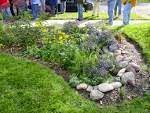 |
| Develop a Rain Garden |
deluge of water, as well as in many locations the untreated water results in natural waterways.
The EPA estimates around 70 percent from the pollution in our
streams, rivers, and lakes is carried there by storm water! By taking
responsibility for that rainwater that falls on your own roof and driveway, you'll
be helping protect our rivers, streams and lakes from stormwater pollution.
To lessen the surplus water runoff, many towns are encouraging businesses and
homeowners to put in rain gardens in their yards. Rain gardens are specially constructed gardens positioned in low aspects of a yard where storm water can collect.
The thought is always to possess the water naturally funnel to this particular garden. The rain garden collects water runoff and stores and filters it until it could be slowly absorbed because of the soil.
As an alternative to rushing off right into a storm sewer or possibly a local waterway, the rainwater can collect within a garden where it's going to be naturally filtered by plants and soil. Installing a rain garden is straightforward.
Simply dig a shallow depression within your yard and plant it with native
grasses and wildflowers; items that are really simple to grow and look after in your town.
Have no idea of garden a rain garden? First, a garden are going to be fashioned with a low spot at the center to accumulate and absorb rain water and snow melt. This depression ranges from a few inches in a small garden, for an excavated trough that's several feet deep.
Second, rain gardens are often located where they'll catch
the runoff from impermeable surfaces like sidewalks and driveways, or from gutters
and roof valleys. Third, rain gardens tend to be planted with native wildflowers and grasses that will thrive in tough growing conditions.
Finally, rain gardens
are created to channel heavy rains to a different rain garden as well as to another section of
your backyard. Your rain garden really should be located at the least 10 feet in the house. Your garden’s size and is dependent upon the yard.
The best situation should be to locate the backyard in the depression. Moreover , you may can funnel water from downspouts on gutters in the garden. The soil must be well drained
so the water doesn’t sit within the garden more than 2 days. A unique rain garden” soil mixture of 50 to 60 percent sand, 20 to 30 % topsoil,
and 20 to 30 % compost is recommended.
You can dig this mixture into
the soil to depth of two feet before planting.
After you have identified the new garden's location, take away the sod and dig a shallow depression approximately 6-inches deep. Slope the sides gradually externally edge on the deepest area.
Utilize the soil you remove to build up a rather raised area within the lowest side on the garden. This berm may help contain
the stormwater and allow it to percolate slowly with the rain garden.
Should your rain garden isn't more than about 6-inches deep, stormwater will often be absorbed with a one- to seven-day period. Because mosquitoes require seven to ten days to lay and hatch their eggs, this will help avoid mosquito problems.Your downspout or sump pump outlet must be aimed your rain garden
depression. You can accomplish this by way of natural slope, by digging a shallow swale, or by piping the runoff straight away to your garden by using a buried 4" diameter plastic drain tile. Plant Selection..
The final touch.
By far the most difficult section of developing a rain garden (whether or not this could even be called that) can be plant selection. Plants must be tough enough to face up to periodic flooding,
yet attractive enough to look good from the garden. Deep-rooted, low-care native plants, including asters, and difficult non-natives, like daylilies, would be better. If
properly designed, the rain garden can contain a mix of attractive shrubs, perennials, trees, and ground covers.
Planting strips of grass throughout the
garden and taking advantage of mulch could also help filter the stream.
New plants must be watered almost daily for that first two weeks or possibly even longer.
When they are very well established, your garden should thrive without additional watering.
Fertilizers are not necessary, in support of minimal weeding are going to be needed after
the initial summer of growth.










0 comments:
Post a Comment